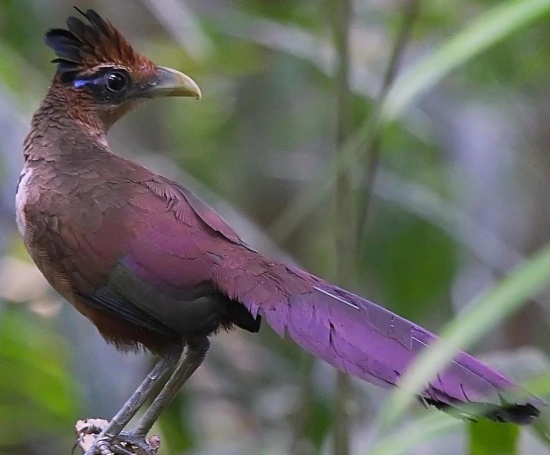- Neomorphus geoffroyi
Identification
50cm. A large Ground Cuckoo.
- Black crest
- Buff to cinnamon-brown forehead
- Breast with dusky seicircular bands, narrow black band on chest
- Blue bare facial skin, brown eye
- Large, yellow-green bill
- Glossy green wings
- Buff underparts with rufous vent
- australis with unmarked crest
- dulcis dark blue above
- maximiliani dark bronze-green above with purplish tail
- aequatorialis with warm brown forehead, bronzy-green upperparts and broad pale tips on breast feathers
Juveniles are duller and darker.
Distribution
From Nicaragua south to Costa Rica, Panama, Colombia, Ecuador, Peru, Brazil and Bolivia.
Rare and local.
Taxonomy
Five to six subspecies recognized:
- N. g. salvini in the humid lowlands of Nicaragua to Pacific coast of Colombia
- N. g. aequatorialis from tropical southeast Colombia to eastern Ecuador and northern Peru
- N. g. australis in southern Peru and northwest Bolivia
- N. g. geoffroyi in Brazil south of the Amazon (Pará)
- N. g. dulcis in eastern Brazil (Espírito Santo to Rio de Janeiro)
- N. g. maximiliani in eastern Brazil (Bahia) - not accepted by Clements.
Scaled Ground Cuckoo is sometimes included in this species.
Habitat
Moist lowland forests.
Occurs in lowland and foothills up to 1200m, up to 1650m in Bolivia.
Behaviour
A terrestrial species, wary and agile. Usually seen running on the ground, only rarely flying.
Diet
Feeds on large insects, centipedes, scorpions, spiders, lizards, small frogs and sometimes seeds and fruit.
Often forages at army ant swarms, also follows peccaries.
Breeding
North of northern Colombia breeds in northern summer or in the wet season. In southeast Brazil breeding season in southern summer. The nest is a broad shallow bowl made of sticks and placed in dense, swampy vegetation. Lays 1 egg.
Movements
This is a resident species.
References
- Clements, J. F., T. S. Schulenberg, M. J. Iliff, B.L. Sullivan, C. L. Wood, and D. Roberson. 2013. The eBird/Clements checklist of birds of the world: Version 6.8., with updates to August 2013. Downloaded from http://www.birds.cornell.edu/clementschecklist/download/
- Del Hoyo, J, A Elliot, and J Sargatal, eds. 1997. Handbook of the Birds of the World. Volume 4: Sandgrouse to Cuckoos. Barcelona: Lynx Edicions. ISBN 978-8487334221
Recommended Citation
- BirdForum Opus contributors. (2025) Rufous-vented Ground Cuckoo. In: BirdForum, the forum for wild birds and birding. Retrieved 4 May 2025 from https://www.birdforum.net/opus/Rufous-vented_Ground_Cuckoo






